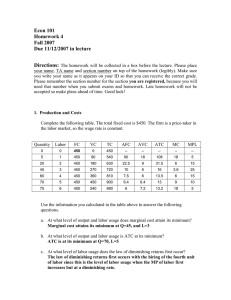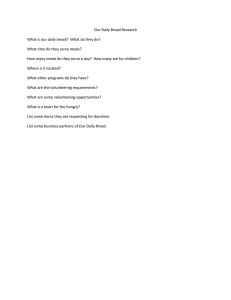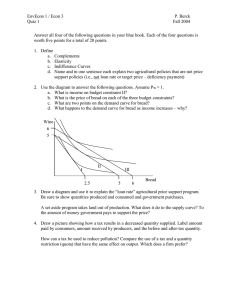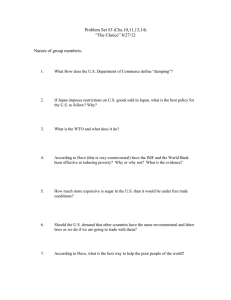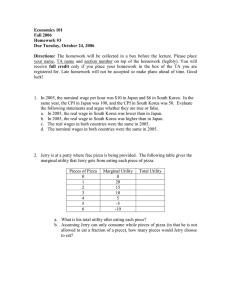Econ 101 Homework 4 Fall 2007 Due 11/12/2007 in lecture
advertisement
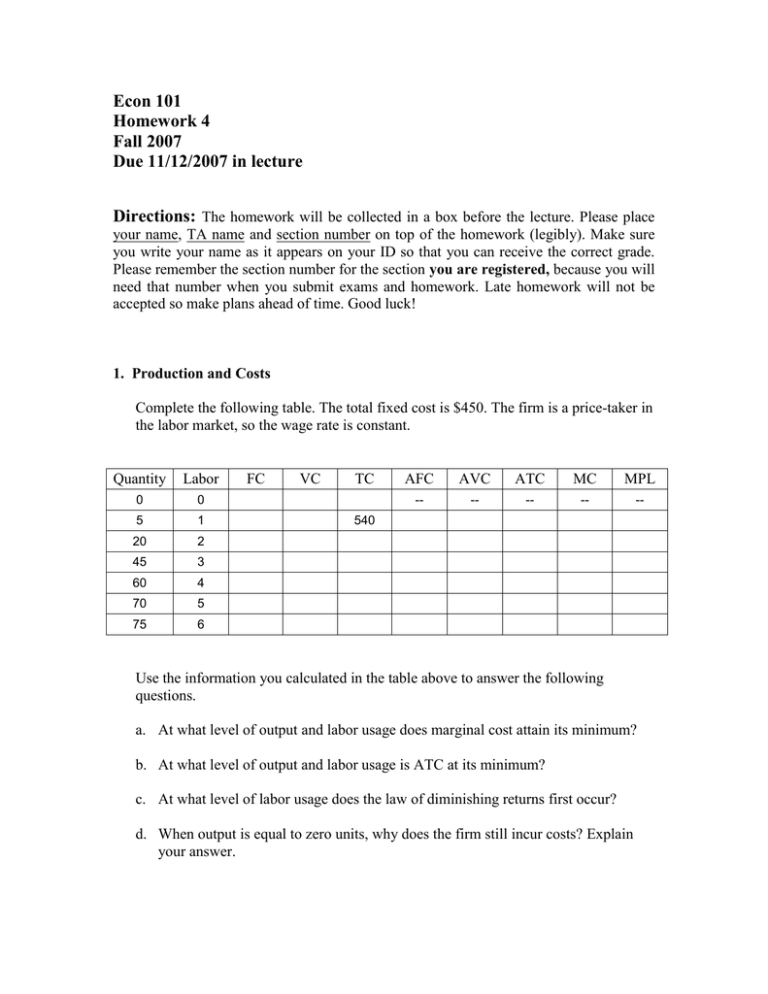
Econ 101 Homework 4 Fall 2007 Due 11/12/2007 in lecture Directions: The homework will be collected in a box before the lecture. Please place your name, TA name and section number on top of the homework (legibly). Make sure you write your name as it appears on your ID so that you can receive the correct grade. Please remember the section number for the section you are registered, because you will need that number when you submit exams and homework. Late homework will not be accepted so make plans ahead of time. Good luck! 1. Production and Costs Complete the following table. The total fixed cost is $450. The firm is a price-taker in the labor market, so the wage rate is constant. Quantity Labor 0 0 5 1 20 2 45 3 60 4 70 5 75 6 FC VC TC AFC AVC ATC MC MPL -- -- -- -- -- 540 Use the information you calculated in the table above to answer the following questions. a. At what level of output and labor usage does marginal cost attain its minimum? b. At what level of output and labor usage is ATC at its minimum? c. At what level of labor usage does the law of diminishing returns first occur? d. When output is equal to zero units, why does the firm still incur costs? Explain your answer. e. As output increases, why does AVC first decrease, but then eventually increase? Explain your answer. f. Suppose the price of output is $20, fill in the following table using the information you gathered in the above table. Quantity 0 5 20 45 60 70 75 MC --- TR TC Profit = TR - TC --- 2. Perfect Competition Consider a competitive industry with a large number of firms. Assume that all the firms have identical cost functions. Suppose that initially the demand curve for this industry is given by Q = 52 – P where Q is the market quantity and P is the market price. Furthermore an individual firm’s total cost and marginal cost are given by the following equations: TC = q2 + 1 MC = 2*q where q is the quantity supplied by the firm. a. What is the breakeven price for this firm? b. At the long-run profit maximizing level of output for the firm (i.e. that level of output where MR = MC = min ATC), what will be the equilibrium output in this industry? c. What will be the equilibrium output of each firm in the long-run if each firm is identical and each firm is profit maximizing? d. What will be the equilibrium number of firms in this industry in this long-run equilibrium? e. Now suppose the government levies an excise tax of $2 on consumption of this good. What will be the equilibrium number of firms? What will be the long-run equilibrium price? f. Return to the original situation and now suppose that due to environmental legislation, the fixed cost of production in every firm increases from 1 to 4. What is the new total cost function? (Marginal cost remains the same). g. Suppose the market price is equal to $2 per unit. How do short-run profits change due to the environmental legislation in part (f)? To answer this question you will first want to figure out the profit maximizing level of output for the firm, then check to make sure that the price of $2 is sufficient to cover the firm's AVC since the firm will choose to shut-down in the short run if it cannot cover its AVC. Then, if the firm does produce you can figure out the firm's short-run profits by calculating the difference between its total revenue and its total cost. h. What do you anticipate will happen in the long-run in this market and what will be the effect of this change on long-run profits? In your answer make sure you identify the level of long-run profits for a representative firm, the long-run level of output for a representative firm, the long-run equilibrium price level, the market level of output, and the number of firms now producing in this market. 3. Income effect and substitution effect Sally only consumes bread (x) and soda (y). Her indifference curves take the form x*y = c where x is the number of units of bread, y is the number of units of soda and c is the total level of utility. Sally’s income is $16. When the price of bread is $4 (Px=$4) and the price of soda is $1 (Py=$1), Sally’s optimal choice is on indifference curve x*y = 16. a. Fill in the following table based upon the equation xy = 16 where x is the number of units of bread and y is the number of units of soda. X 1 Y 8 4 8 1 b. Draw the graph placing bread on the horizontal axis and soda on the vertical axis. Assume that the indifference curve is linear between the different coordinate points you found in the table in part (a). How many units of bread and sodas does Sally consume given these prices? What is her MRS between bread and soda at her optimal consumption bundle? Now the price of bread falls to $1. Sally’s new optimal choice is on indifference curve x*y=64. c. Fill in the following table based upon the equation xy = 64 where x is the number of units of bread and y is the number of units of soda. X Y 1 2 4 8 16 32 64 d. What is Sally’s optimal consumption bundle under the new prices? And what is her MRS between bread and soda at the new optimal consumption bundle? (Hint: you may want to draw in the new budget line and the new indifference curve on your original graph.) e. What are the substitution effect and income effect for the change in Sally’s consumption of bread? Illustrate them on your graph, and calculate the change in bread consumption due to the substitution effect and the change in bread consumption due to the income effect. f. Is bread a normal good or an inferior good for Sally? Is soda a normal good or an inferior good for Sally?
